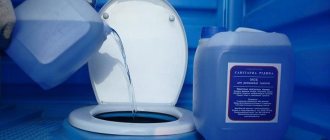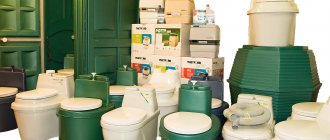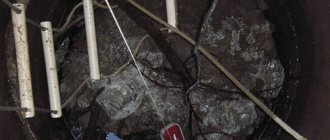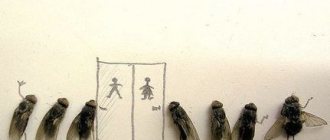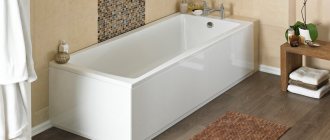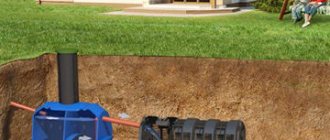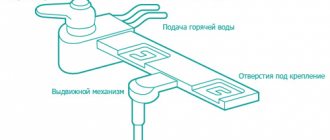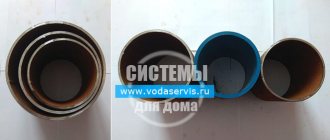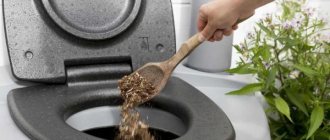Mobile cubicles for dry toilets have long become commonplace and do not cause any surprise. They are used when it is not possible to install a stationary toilet or it is not economically feasible. Mobile toilets have proven themselves to be excellent during public events: sporting competitions, rallies, regional holidays, as well as in places where people spend their summer holidays. Installing permanent toilets would be too expensive. Those who have used dry closets have probably noticed that the waste collection tank contains some kind of pleasant but pungent-smelling liquid, usually blue or blue in color. This is a special product for dry closets; in this article we’ll talk about it in more detail.
All of the above applies not only to stationary toilet stalls, but also to compact dry closets sold in building materials and garden supply stores. In addition, dry toilets are installed in transport: on airplanes, on boats, ships, on good trains and in some cars (tourist buses and campers).
What is liquid for mobile toilets used for?
Some people mistakenly believe that the liquid is used to clean toilets: toilet bowls, seats. However, this is not true: the product is not designed for cleaning, moreover, it cannot be used for this purpose. It does not dissolve salt deposits or remove limescale. Why do you need liquid for dry toilets?
She has three main tasks:
- Aromatization of air and tank contents.
- Disinfection of human waste.
- Processing waste either into a neutral substance without an unpleasant odor, or to produce a valuable fertilizer.
To implement these tasks, two tools are produced:
- For use in the top tank.
- For use in the lower tank.
Let's talk in more detail about what these tanks are and what they are needed for.
Characteristics of an organic reagent
The properties of such a product are manifested in such a way that the living bacteria that are part of it and produce special enzymes destroy waste. Typically, the reagent consists of a mixture rich in natural beneficial microorganisms and enzymes that correspond to them.
The organic reagent for dry toilets is peat. The principle of operation is that a small amount of peat mixture is placed in the lower waste tank, creating an aerobic environment that promotes waste decomposition. The composition of such a mixture includes microorganisms that process waste; leavening agents that increase air access; special absorbers of unpleasant odors. With a dosed supply of peat mixture, waste is converted into environmentally friendly compost.
Upper and lower tank
If you have a flush toilet, this means that it has two tanks: an upper and a lower one.
The upper tank is used to fill water or other liquid to flush. The lower tank collects human waste, as well as toilet paper and napkins. The top can be filled with:
- Water.
- Special flavored product.
It is clear that in transport and other public places, special agents are rarely poured into the upper tank: it will be too expensive. Make do with plain water. Only the most reputable companies can afford this, but it is quite possible to equip such a toilet at your own dacha.
A product intended to disinfect the contents and transform it into a safe substrate is poured into the lower tank. From here it is clear that different products are produced for the upper and lower tanks; they should under no circumstances be confused. Bottom fluids are commonly called breakers because they actually break down complex organic molecules into simpler ones.
Preparations with ammonium
Products used to decompose fecal matter containing ammonium are considered high-quality. They act quickly and effectively, and remarkably eliminate unpleasant odors. The disadvantage of this product for cesspools is its greater sensitivity to environmental aggressiveness, as well as poor interaction with various household chemicals. For example, if after a shower or washing soap solutions get into the drains, the ability of such a product to liquefy waste is reduced several times. It is worth noting another important point: the effect of ammonium on the environment has not been fully studied.
Types of splitters
The industry produces three main types of splitters, which differ fundamentally in their mode of action:
- Ammonium . Decomposition occurs under the influence of nitrogen. To do this, it is necessary that no oxygen enters the tank. Human waste is broken down to its simplest components, the unpleasant odor disappears, and can be used in compost heaps to produce organic fertilizer;
- Formaldehyde . The substances are toxic and dangerous to humans, but they quickly disinfect waste. They are good to use for quick disinfection, for example, in toilets installed at public events;
- Biological . The most environmentally friendly way: anaerobic bacteria process waste into a safe substance, also suitable for fertilizers. This method is loved by summer residents and all lovers of ecology, but it has two significant drawbacks: the process is very long (at least ten days), and the cost of the product is high.
Ammonium splitters are used mainly in compact, portable dry closets. The cost of the product is approximately 250 rubles per liter, it lasts for three months. Formaldehyde disintegrators can only be used when the contents of the tank are poured into the central sewer. Therefore, in summer cottages, in country houses with local sewerage or without it at all, the liquid cannot be used: it will poison the soil. Biological digesters can be used when the volume of waste is small so that it has time to be processed, or a large tank is needed to drain the sewage.
The principle of operation of a dry toilet
Waste disposal occurs under the influence of biological or chemical reagents. Waste is converted into a homogeneous mass, which is subsequently disposed of and does not have a harmful effect on the environment.
Depending on the reagent used to dispose of waste, dry toilets can be divided into several types:
- Biological, containing biological substances - peat, sawdust, live bacteria. The resulting waste product is useful as fertilizer.
- Chemical, which uses chemical liquids that destroy odors and germs.
- Electric, where waste is separated into liquid and solid phases and distributed into different containers. Works using electricity.
What to look for when choosing
There are deodorizing liquids for the flush tank and liquid-splitting liquids.
A huge variety of products are sold on store shelves and online.
How to choose a remedy?
- Pay attention to the manufacturer . It is better to buy a product from a trusted manufacturer that has received good customer ratings. However, there may be products on the market from young, start-up companies that are not inferior in quality to products from well-known manufacturers, but are much cheaper.
- Price . You have to be careful here. The price per bottle says absolutely nothing, since the product is usually sold in the form of a concentrate, which must be diluted with water in certain proportions. These proportions are indicated on the label, so it will be useful to calculate how much ready-made solution can be made from a given bottle, and only then compare the price of a liter of ready-made solution.
Example
Remedy 1 . Price per liter is 1000 rubles, consumption is 100 milliliters per 10 liters of the volume of the lower tank. From this we see that to break down 1 liter of waste you need 10 milliliters of product worth 10 rubles.
Remedy 2 . Price per liter is 1600 rubles, consumption is 50 milliliters per 10 liters of the volume of the lower tank. For 1 liter of waste you will need 5 milliliters of product worth 8 rubles.
This shows that the second product is more profitable, although the price per liter is higher. In all cases, the product concentrate is first pre-dissolved in a small amount of water and then poured into the tank.
- Customer reviews . You should carefully read what users of the funds write. It’s no secret that there are a lot of custom reviews on the Internet (both laudatory and critical). Therefore, it is best to ask your friends or look on those sites where there is serious moderation of reviews (Otzovik, Yandex Market, etc.).
- Features of the action . Some products are effective only after four or five days of use, others after six days, some even require a week and a half to neutralize impurities.
The temperature range is also important: rarely, but still there are cases when dry closets are used in severe frosts. For these cases, you need a special non-freezing liquid that can withstand frosts down to minus 40 degrees Celsius.
Features of biological products
Any biochemical product for dry toilets and cesspools contains various bacteria, which, once in the mass of wastewater, help displace putrefactive microflora and help decompose solid inclusions, as well as the formation of sludge. The latter is usually used as an environmentally friendly organic fertilizer.
Biological drugs can be in the form of solutions, tablets or powder, which are diluted in water in advance. They also have disadvantages, including sensitivity to environmental factors. Such microflora can only exist at temperatures from +5 to +35 degrees. In addition, when using a product for dry toilets and cesspools, you should carefully select detergents for dishwashers and washing machines, disinfectants and cleaning compounds for plumbing. Some of them lead to the destruction of beneficial bacteria if they get into the sewer or septic tank.
Review of the most popular tools
Thetford
Everything is simple here: the recognized world leader in chemical toilet products is the Thetford company (Netherlands). Its products invariably receive positive and even rave reviews.
The company produces three types of liquids, which are easily distinguished by the color of the cap:
- Bottles with pink caps are for upper tanks (deodorizing solution).
- Bottles with green and blue caps are for lower tanks.
The product in bottles with blue caps is poisonous and is made from formaldehyde. Allows you to quickly disinfect sewage; treated products can be poured into a regular sewer. The product in bottles with green caps contains bacteria that safely convert sewage into neutral and useful fertilizer.
The main advantages of Thetford products:
- Complete neutralization of unpleasant odors.
- The product's own scent is subtle and not pungent.
- Withstands light frosts well.
- Child protection.
Protecting the bottle from children is a unique and very useful invention of the company. There have been cases when children accidentally drank some solutions containing household chemicals. To prevent this, the bottle is designed quite cleverly: to open it, you need to squeeze the neck and pull the cap up.
Buyers generally evaluate all types of products positively. For example, here is one of the reviews.
Tamara K., 35 years old, Kazan:
“We bought liquid with a green stopper Aqua Kem Green 0.375 l for our country dry toilet. At first I didn’t read the instructions and applied an overly strong solution, then it turned out that a much smaller volume was enough. I liked that the concentrate is not smelly and does not corrode your hands, and I was amused by the childproof lid. Completely neutralizes the smell of sewage and converts it into a neutral mass, which we use as fertilizer. You just need to remember to drain the contents every four days, or even better, every third day. We found no downsides, except for the high price. If we find some Russian analogue with a lower price, we’ll try that too.”
Biola
A Russian brand that has received many positive reviews in recent years. It has a simpler composition than the Dutch product, its consumption is higher, but it costs three times less, so it makes sense to try it. Sold in simple bottles without any special frills, there are two varieties available: for upper and lower tanks.
It does not allow you to make compost from sewage (however, this is unlikely to be important for many), but it effectively neutralizes unpleasant odors and quickly decomposes waste. Does not contain components hazardous to human health. Can be used to deodorize ordinary cesspools in villages.
Goodwin (Goodhim)
Refers to products made on the basis of ammonium, which converts sewage into useful fertilizer (compost). The disadvantages include the high price (twice as expensive as Biola), and a pungent, specific smell.
Live bacteria
A young Russian company that produces cheap products in economical packaging for the bacterial breakdown of sewage. Very cheap, suitable for large volumes of waste. 74 percent of respondents assessed it positively (Yandex Market data).
Bioforce
A Russian manufacturer that produces a wide range of household chemicals, liquid for dry toilets is just one of the many types of products produced. It is a biological product for the lower toilet cistern and is very economical in consumption: 50 milliliters of product per 10 liters of tank volume.
Septicsol
Canadian product for dry toilets. Reviews say that it quickly neutralizes odors and disinfects sewage, but many believe that the substance has too pungent an odor.
BIOwc (Bionics)
Production St. Petersburg. It has an extremely low price (approximately 550 rubles for a five-liter canister), and is highly concentrated: consumption of 50 milliliters of product per 10 liters of the volume of the lower tank. The packaging is nondescript, it is clear that the manufacturer sought to make the product as cheap as possible. Convenient, economical packaging that will last for a very long time. Due to the low price, demand exceeds supply and is difficult to find on sale. Of the minuses: it is afraid of even minor frosts.
Compatibility
However, it is difficult to imagine how long it takes for waste to be broken down in a chemical dry closet without the addition of catalysts. By adding a biotoilet splitter, the intensity of the reactions increases many times.
The use of chemicals destroys all living things in the container and completely breaks down the waste contained there.
When using biological additives, which are a set of enzymes and bacteria, the entire effect can be reduced to zero if the ampa green 2 liter home dry toilet liquid added to the drain tank contains chemically active substances. Yes, such a product in the drain tank and receiving container will destroy bacteria and remove unpleasant odors, but if it gets into the storage tank, all the bacteria that contribute to natural processing will also die under the influence of chemicals. The processing process will be significantly slowed down. For the same reason, it is not recommended to throw household chemical products into the dry closet.
To avoid this situation, before filling the dry closet with liquid, you should ensure that it is compatible with the biological disintegrator used. The most convenient and reliable option is to use a disintegrator and an antiseptic from the same manufacturer. Such products are initially manufactured in such a way that their action does not work by mutual exclusion, but rather complements each other.
A similar solution is offered by the American company Thetford, which has been operating on the market for more than fifty years. By purchasing the Thetford AquaKemGreen disintegrator, you can also buy thetford AquaRinse composting toilet liquid, which is designed to be added to the clean water of the cistern. “AquaRinse” is a deodorizing liquid that does not affect the quality of waste processing by the “AquaKemGreen” digester in a storage container.
For those who like to make things with their own hands
There will always be people who prefer to do everything with their own hands. Especially for them there is a simple recipe for an effective remedy for the lower tank:
- Take 75 grams of starch and 25 grams of table salt.
- Mix thoroughly and add 100 grams of water.
- Place the mixture on the fire, heat until it reaches a uniform consistency, stirring continuously.
- Cool the mixture.
- Add aromatic oil of your choice.
- Add 20 milliliters of table vinegar.
- Add 10 grams of liquid soap.
What liquid do you use for dry toilets?
AmmoniumBiological
This product has a shelf life of no more than two weeks, its effectiveness is low, but can be used in the absence of a professional product at hand.
Difference from purchased
There are many recipes for making a chemical toilet product, all of which are cheaper than the formulations sold in stores. But you need to take into account one nuance - the manufacturer provides a guarantee for the product produced. And all drugs that go on sale are certified and also undergo a large number of tests.
When independently experimenting with different chemical compositions, all risks are on the shoulders of the owner of the dry closet. It’s great if feces disposal is connected to the pipeline of a centralized sewerage system. If waste is used to fertilize a personal plot, then many questions arise regarding the purity of cultivated plants grown with this product.
Most often, bio-toilets are installed as a temporary solution to the main problem, and the purchase of bio-fluid for one year does not constitute a big loss for the family budget. It is for this reason that the likelihood of significant costs for splitters is excluded.
Conclusion
The industry produces numerous types of products for dry toilets. When choosing, you should focus on the criteria described above. In addition, we should not forget that household chemicals may contain toxic substances, so they should be kept out of the reach of children. Please note that most products are frost-resistant; for cold climates you need to choose special liquids. If money allows, it is better to buy expensive imported high-quality toilet fluids; if savings are important, then domestic products are also suitable.
Features of chemical cleaning
A chemical product for dry closets and cesspools can operate at absolutely any temperature, which makes it possible to reduce the level of requirements for the operation of such products.
If chemicals are used, then it does not matter what household chemicals are used. In addition, such products do not care about the quality of water.
Chemicals have the following disadvantages:
- there is a risk of toxic substances getting into the soil;
- aggressiveness of the composition towards metal sewer pipes and other elements of the system.
Chemicals are best used for tanks and pipes made of polymer materials that are resistant to such influences.
Bioactivators
Bioactivator for cesspools
This version of an antiseptic for a toilet is best suited for installation in a country house, since the breakdown of waste occurs without harm to the surrounding area. But fruits and vegetables are grown at the dacha, so they cannot be allowed to become contaminated. However, for the normal functioning of bacteria, special conditions are necessary: moisture, light, temperature. With the help of such microorganisms, you can quickly get rid of sewage, prevent the development of fungi and eliminate unpleasant odors. In addition, moisture is absorbed into the soil, so the contents of the hole become smaller and smaller. You can purchase a biological antiseptic in the form of tablets, powder or liquid. For a small toilet, you can use just one tablet. But if it is large and the whole family uses it, then it is better to add powder or liquid. sexe24
It must be taken into account that biobacteria are inactive in tablets and powders. Therefore, you need to activate them yourself. To do this, they are mixed with cold water and left for a certain time. Immediately after the liquid enters the cesspool, the cleaning process will begin. Bacteria feed on sewage and multiply. Therefore, over time, waste breakdown will occur even faster.
How to use it?
Application of a bioactivator
Since bioactivators are living organisms, in order for them to function normally, it is necessary to follow certain rules:
- Under no circumstances should chemicals and medications that can kill bacteria get into the cesspool;
- The water level in the pit should be approximately 20 cm above the solid elements;
- Be sure to provide ventilation for the toilet, since bacteria also need fresh air;
- Bacteria are killed by exposure to cold. Therefore, it is not recommended to use them in winter, early spring or late autumn;
- If you do not add enough bacteria to the pit, they will not be able to cope with all the waste, so they will die over time.
